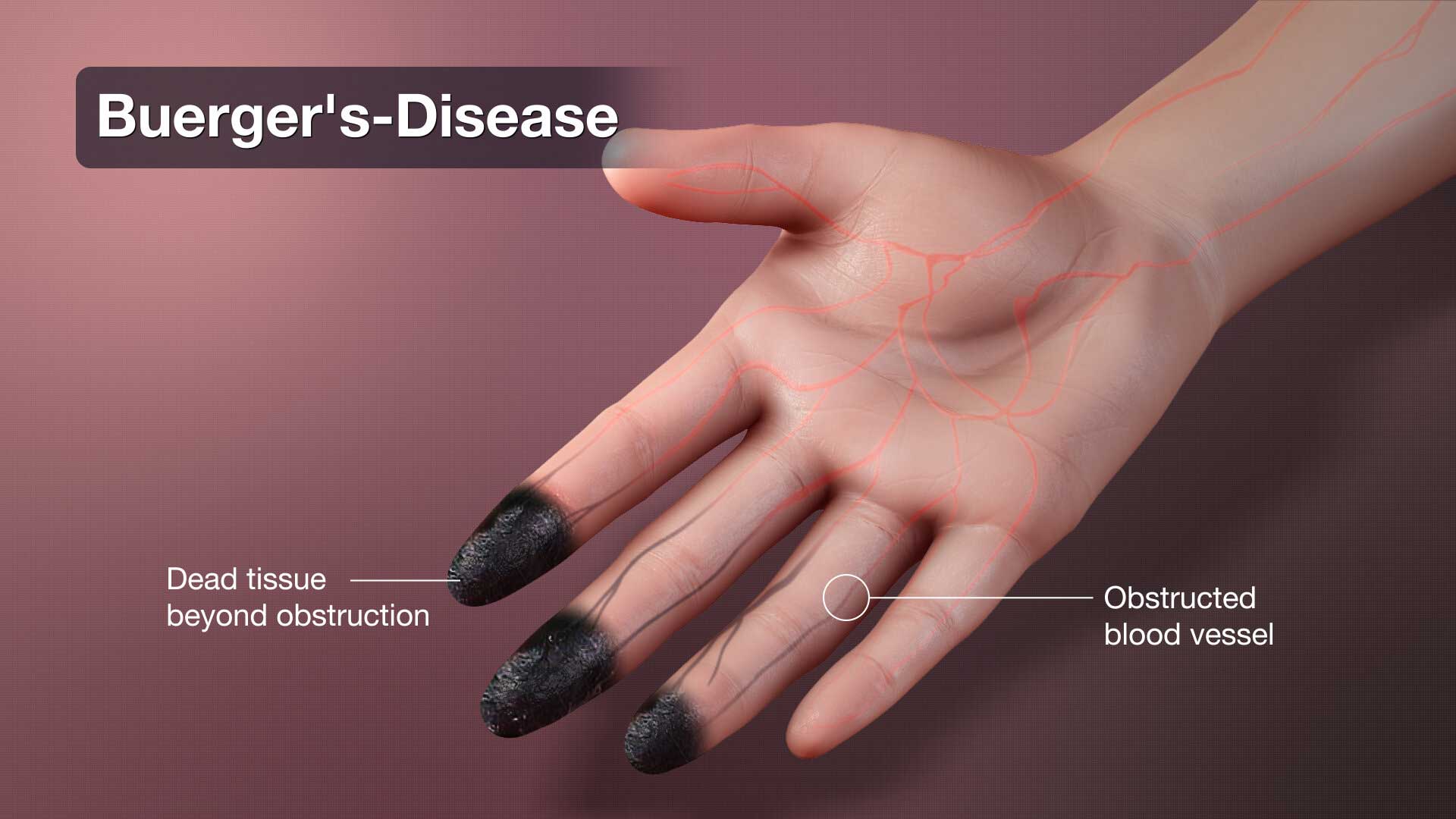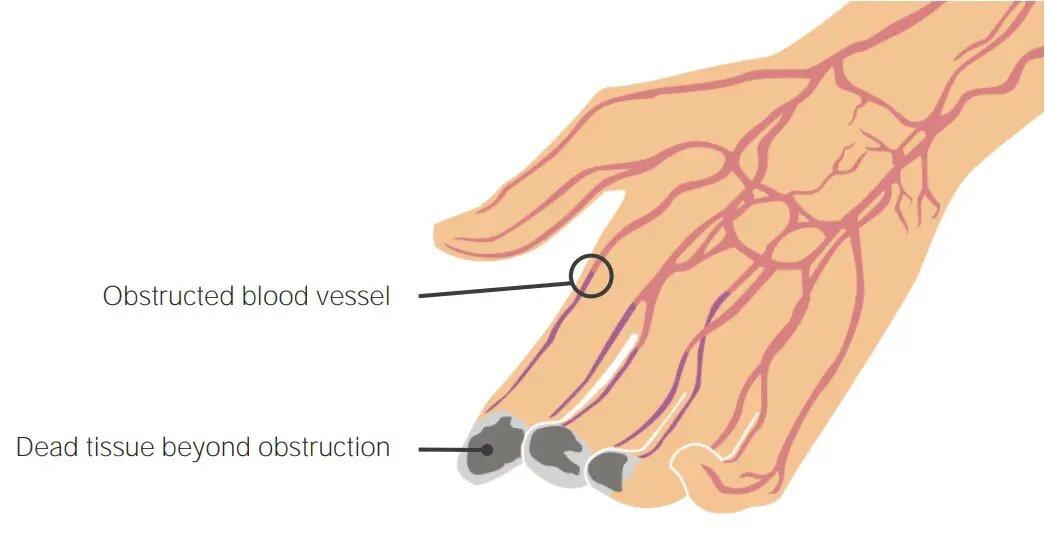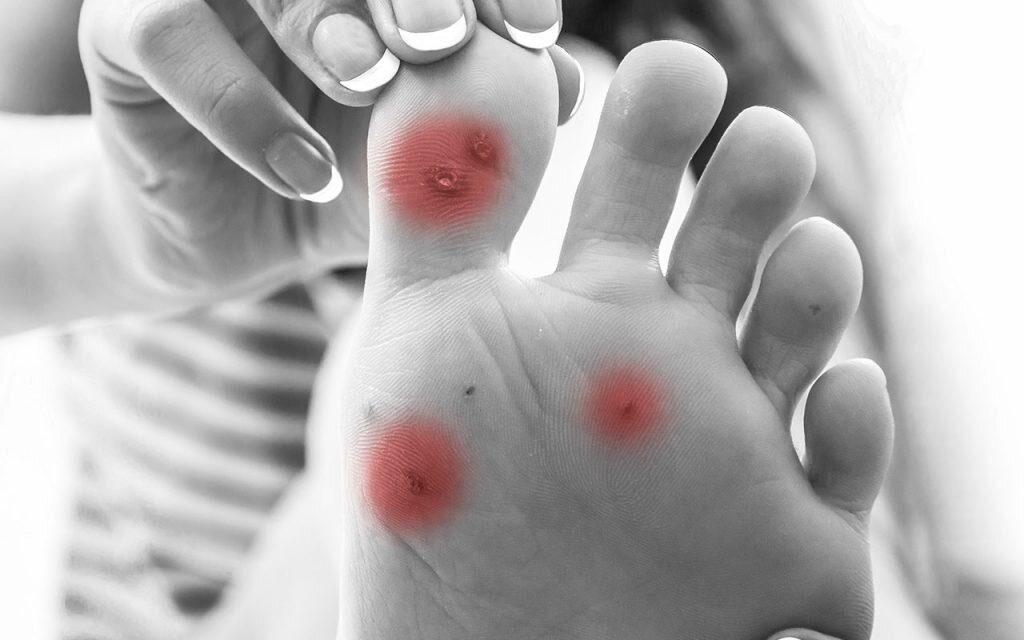WHAT IS BUERGER’S DISEASE?
Buerger’s disease is an unusual disease of the arteries and veins in the arms and legs. In Buerger’s disease also known as thromboangiitis obliterans, your blood vessels become inflamed, swollen, and could become blocked with blood clots (thrombi).
This ultimately damages or destroys skin tissues and might lead to infection and gangrene. Buerger’s disease generally first shows in your hands and feet and might ultimately damage larger regions of your arms and legs.
Virtually everyone who has been diagnosed with Buerger’s disease smokes cigarettes or uses other types of tobacco, for example chewing tobacco. Quitting all types of tobacco is the only way to prevent Buerger’s disease. For those who do not quit, amputation of all or part of a limb is sometimes required.
BUERGER’S DISEASE SYMPTOMS
Buerger’s disease signs and symptoms include:
- Tingling or numbness of hands or feet.
- Pale, reddish, or blue-tinted hands or feet.
- Pain that might come and go in your legs and feet or in your arms and hands. This pain might happen when you use your hands or feet and eases when you stop that activity (claudication), or when you are at rest.
- Inflammation along a vein just below the skin’s surface (because of a blood clot in the vein).
- Fingers and toes that become pale when exposed to cold (Raynaud’s phenomenon).
- Painful open sores on your fingers and toes.
 WHEN SHOULD YOU SEE A DOCTOR?
WHEN SHOULD YOU SEE A DOCTOR?
See your doctor or primary care physician if you think you might have signs or symptoms of Buerger’s disease.
BUERGER’S DISEASE CAUSES
The accurate cause of Buerger’s disease is not known. Although tobacco use clearly plays a role in the development of Buerger’s disease, it is unclear how it does this. It’s thought that chemicals in tobacco might irritate the lining of your blood vessels, causing them to swell up.
Experts suspect that some people might have a genetic predisposition to the disease. It is also possible that the disease is caused by an autoimmune response in which the body’s immune system by mistake attacks healthy tissue.
BUERGER’S DISEASE RISK FACTORS
TOBACCO USE
Cigarette smoking highly increases your risk of Buerger’s disease. But Buerger’s disease could happen in people who use any type of tobacco, including cigars and chewing tobacco.
People who smoke hand-rolled cigarettes using raw tobacco and those who smoke more than a pack and half of cigarettes a day might have the highest risk of Buerger’s disease. The rates of Buerger’s disease are highest in regions of the Mediterranean, Middle East, and Asia where heavy smoking is most common.
CHRONIC GUM DISEASE
Long-term infection of the gums has been associated with the development of Buerger’s disease, but the reason for this connection is still unclear.
SEX
Buerger’s disease is far more prevalent in males than in females. Although, this difference might be linked to higher rates of smoking in men.
AGE
The disease usually first appears in people less than 45 years old.
BUERGER’S DISEASE COMPLICATIONS
If Buerger’s disease gets worse, blood flow to your arms and legs reduces. This is because of blockages that make it difficult for blood to reach the tips of your fingers and toes. Tissues that do not receive blood do not get the oxygen and nutrients they require to survive.
This could cause the skin and tissue on the ends of your fingers and toes to die (gangrene). Signs and symptoms of gangrene include black or blue skin, a loss of feeling in the damaged finger or toe, and a foul smell from the damaged region. Gangrene is a severe condition that generally needs amputation of the damaged finger or toe. Buerger’s disease signs and symptoms include:

BUERGER’S DISEASE PREVENTION
QUIT USING TOBACCO IN ANY FORM
Virtually everyone who has Buerger’s disease has used tobacco in one form or another, mostly cigarettes. To prevent Buerger’s disease, it is crucial to not use tobacco.
Quitting smoking could be difficult. If you are like most people who smoke, you have probably tried to quit in the past. It is never too late to make another attempt. Talk to your doctor or primary care physician about strategies to help you quit.
BUERGER’S DISEASE DIAGNOSIS
Although no tests could verify whether you have Buerger’s disease, your doctor or primary care physician will likely order tests to rule out other more prevalent conditions or confirm the suspicion of Buerger’s disease caused by your signs and symptoms. Tests might include
BLOOD TESTS
Blood tests to look for specific substances could rule out other conditions that might cause similar signs and symptoms. For example, blood tests could help rule out autoimmune diseases for example scleroderma or lupus, blood-clotting disorders, and diabetes.
ALLEN’S TEST
Your doctor or primary care physician might perform a simple test known as Allen’s test to check blood flow through the arteries carrying blood to your hands. In Allen’s test, you tighten your fist, which forces the blood out of your hand. Your doctor or primary care physician presses on the arteries on either side of your wrist to slow the flow of blood back in your hand, causing your hand to lose its natural color.
Then you open up your hand and your doctor or primary care physician releases the pressure on one artery, then another. The rate at which the color returns to your hand might give a general indication of the health of your arteries. Slow blood flows into your hand might indicate a problem, for example, Buerger’s disease.
ANGIOGRAM
An angiogram helps to see the condition or state of your arteries. An angiogram could be done non-invasively with the use of CT or MRI scans.
Or it might be done by threading a catheter into an artery. During this procedure, a special dye is injected or administered into the artery, after which you undergo a series of rapid X-rays. The dye helps make any artery blockages easier to see in the pictures.
Your doctor or primary care physician might order angiograms of both your arms and your legs even if you do not have signs and symptoms of Buerger’s disease in all of your limbs. Buerger’s disease almost always damages more than one limb, so even though you don’t have signs and symptoms in your other limbs, this test might discover early signs of vessel damage.
BUERGER’S DISEASE TREATMENT
SMOKING CESSATION
However no treatment could cure Buerger’s disease, the most effective way to prevent the disease from getting worse is to quit using all tobacco products. Even a few cigarettes a day could worsen the disease.
Your doctor or primary care physician could counsel you and suggest medications to help you stop smoking and stop the swelling in your blood vessels. You will require to avoid nicotine replacement products because they supply nicotine, which triggers Buerger’s disease. There are non-nicotine products that you could use.
Another alternative is a residential smoking cessation program. In these programs, people stay in a treatment facility, sometimes in the hospital, for a set number of days or weeks. During this time you participate in daily counseling sessions and other activities to help you deal with the cravings for cigarettes and to help you learn to live tobacco-free.
OTHER TREATMENTS
Other treatment methods exist for Buerger’s disease but are less effective than quitting smoking. Options involve:
- Medicines for dilating blood vessels, improving blood flow, or dissolving blood clots
- Intermittent compression of the arms and legs to enhance blood flow to the extremities
- Spinal cord stimulation
- Amputation, if infection or gangrene happens

POTENTIAL FUTURE TREATMENTS
Nerve surgery – Surgery to cut the nerves to the damaged region (surgical sympathectomy) to control pain and enhance blood flow, however, this procedure is controversial and long-term results have not been well-studied.
Growing new blood vessels – Medications to stimulate the growth of new blood vessels (therapeutic angiogenesis), a method that is considered experimental.
Bosentan (Tracleer) – This medication has been accepted or approved for treating high blood pressure in the lungs. The drug has enhanced blood flow in small studies of people suffering from Buerger’s disease.
Blood vessel procedure – A thin catheter threaded into the blood vessels may open blood vessels, restoring blood flow. However, this procedure known as endovascular therapy is not widely used, it may be effective.
If you or anyone you know is suffering from Buerger’s disease, our expert providers at Specialty Care Clinics will take care of your health and help you recover.
Call 469-545-9983 to book an telehealth appointment for an at home check-up.
